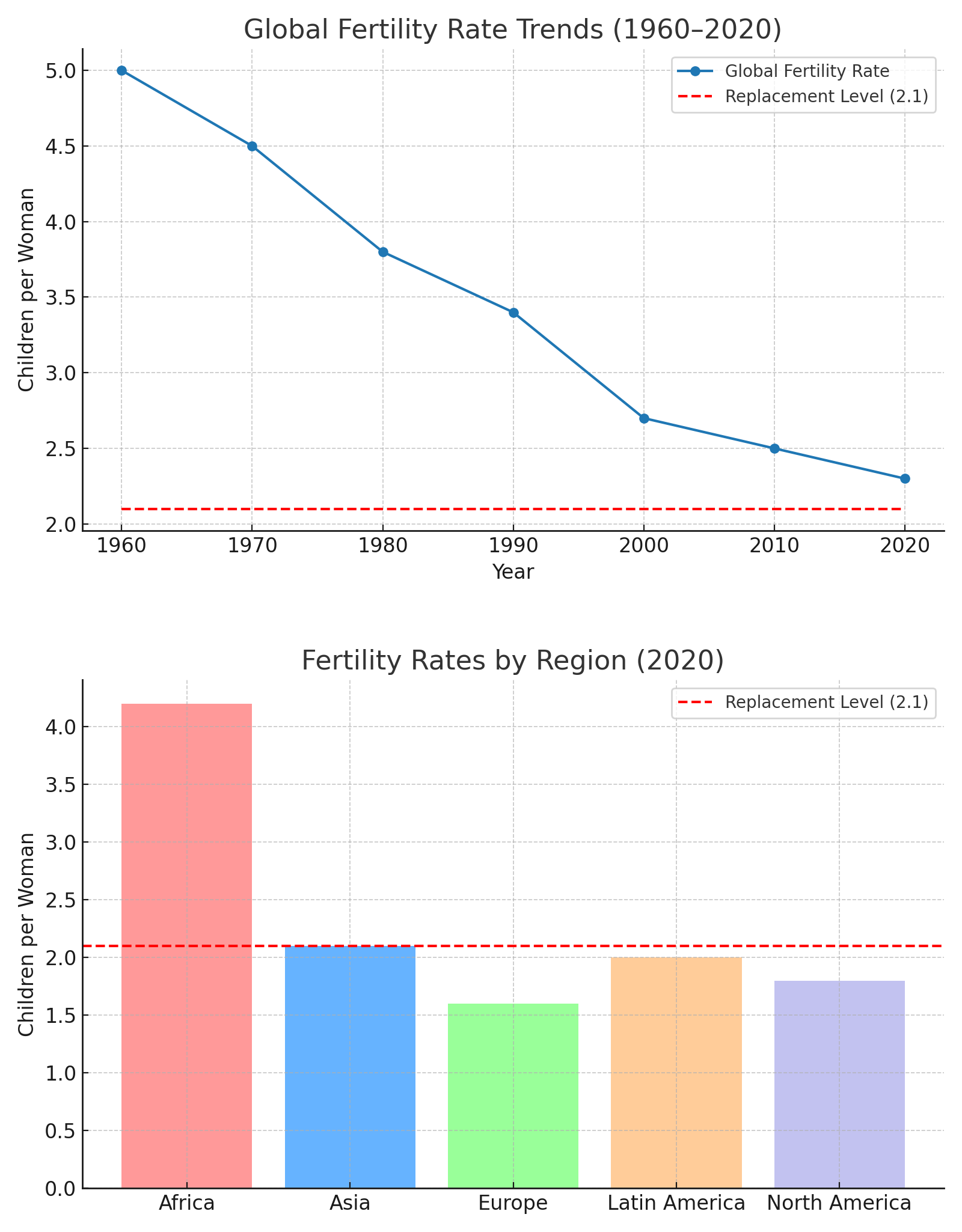The Global Fertility Crisis: What the Numbers Mean for Us
For decades, the world's fertility rate has been quietly but steadily falling. In 1960, the average woman had five children; today, it's just 2.3 and more than half of all countries are now below the replacement level of 2.1 children per woman.
Picture this: In 1960, the average woman had five children. Fast forward to today, and that number has plummeted to just 2.3 children per woman. Even more concerning? More than half of all countries worldwide are now below the replacement level of 2.1 children per woman.
This isn't just a statistic—it's a seismic shift that's reshaping our world in ways we're only beginning to understand. The global fertility crisis isn't happening in a vacuum; it's a complex web of social, economic, and health factors that's affecting every one of us.

🔍 Why Are Fertility Rates Dropping So Dramatically?
While lower fertility rates once signaled progress—better healthcare, education, and economic opportunities—today's decline tells a more complex story. Here's what's really driving this change:
📈 The Modern Life Factor
- Delayed Parenthood: More people are prioritizing careers and financial stability before starting families
- Urban Living: Higher costs of living and smaller living spaces make larger families less practical
- Economic Uncertainty: Financial instability makes families hesitant to expand
🏥 The Health Challenge
- Rising Health Issues: PCOS, declining sperm quality, and stress-related fertility problems
- Environmental Factors: Exposure to toxins and pollutants affecting reproductive health
- Lifestyle Changes: Poor diet, lack of exercise, and increased stress levels
🌍 Social Transformation
- Changing Priorities: Personal choice and lifestyle flexibility over traditional family structures
- Career Focus: Professional advancement often takes precedence over family planning
- Cultural Shifts: Evolving attitudes toward marriage and parenthood
🌐 The Ripple Effect: How This Affects Everyone
This isn't just about individual families—it's about entire societies. Here's what happens when fertility rates fall:
💡 The Big Picture Impact
- Ageing Populations: More elderly people, fewer working-age individuals to support them
- Economic Strain: Pressure on pension systems and healthcare infrastructure
- Labour Shortages: Fewer young people entering the workforce
- Policy Changes: Governments implementing incentives for childbearing
😔 The Human Side: Personal Stories Behind the Numbers
Behind every statistic is a real person with real emotions. For individuals and couples, the fertility crisis hits much closer to home:
⏰ The Time Pressure
Many people feel they've waited too long to start families, only to discover that their fertility options have become limited. The biological clock isn't just a metaphor—it's a real, pressing concern that affects millions.
💔 The Emotional Toll
Infertility can be devastating. It's not just about the physical challenges; it's about the emotional rollercoaster of hope, disappointment, and sometimes grief. Relationships can strain under the pressure, and mental health often suffers.
💰 The Financial Burden
Fertility treatments like IVF can cost tens of thousands of dollars. For many, this creates an impossible choice between financial security and the dream of having a family.
🎯 Why Early Action Matters More Than Ever
Here's the good news: fertility isn't a single moment in life—it's a lifelong journey that we can influence through proactive care and education.
By understanding our reproductive health early, we can make informed decisions about our future. Regular health checks, lifestyle modifications, and early education can protect our fertility options before they become limited.
🛠️ A Holistic Approach to the Fertility Crisis
Solving this crisis requires more than just medical intervention. We need a comprehensive approach that addresses the root causes:
🎓 Education First
Start reproductive health education from adolescence. Knowledge is power, and understanding how lifestyle, nutrition, and emotional health affect fertility can make all the difference.
🏥 Accessible Care
Remove the stigma and barriers around fertility care. Make it affordable, accessible, and judgment-free for everyone who needs it.
🤖 Technology Integration
Leverage AI, wearables, and personalized health tools to guide individuals throughout their reproductive lives. Technology can bridge the gap between awareness and action.
🚀 How ReproAlign Is Part of the Solution
At ReproAlign, we're not just watching this crisis unfold—we're actively working to solve it. Our platform combines emotional wellness, clinical precision, personalized nutrition, and wearable syncing into a single, comprehensive solution.
Our AI-powered co-pilots—Elöra for individuals and RAI for clinics—work together to track cycles, monitor health, and guide decision-making. We're ensuring that fertility care is continuous, connected, and compassionate.
💭 The Bottom Line
The global fertility crisis is more than numbers—it's a defining challenge of our time. But with the right blend of technology, education, and empathy, we can protect reproductive health and ensure every person has the freedom and support to shape their own path to parenthood.
Ready to take control of your reproductive health journey? Join thousands of others who are already using ReproAlign to navigate their fertility with confidence and support.
Ready to Experience ReproAlign?
Join thousands of women who are transforming their reproductive health journey with AI-powered intelligence.